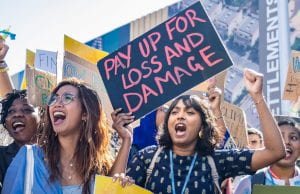by Temitope Tunbi Onifade, University of Bristol Law School
Vanuatu’s proposal for ‘an International Climate Fund to finance measures to counter the adverse consequences of climate change, and a separate International Insurance Pool to provide financial insurance against the consequences of sea level rise’ put the issue of loss and damage on the agenda during the negotiations of the United Nations Framework Convention on Climate Change (UNFCCC) in 1991. This agenda has evolved to refer to negotiations on ways to address extreme weather and slow onset events not fully dealt with by adaptation measures. Powerful jurisdictions such as the United States and European Union uniformly opposed it when it first came up and for many years after. However, this attitude has gradually changed at subsequent meetings of the highest decision-making body of the convention, called Conference of the Parties (COP). There are some notable developments: under Decision 3/CP.18 at the Doha COP in 2012, parties agreed to create ‘institutional arrangements, such as an international mechanism … to address loss and damage…in developing countries….’; the Warsaw COP in 2013 then created this international mechanism, called the Warsaw International Mechanism, and the Paris COP in 2015 formalized this mechanism by including it in the Paris Agreement; the Sharm El-Sheikh COP in 2022 created the loss and damage funding arrangements, including a new pool of fund; and, most recently, these funding arrangements, including the fund, were operationalized at the Dubai COP in December 2023. By operationalization, the committee given the responsibility at the Sharm El-Sheikh COP to work out the details for implementing the funding arrangements, called the Transitional Committee, reported back to the Dubai COP,[1] and the UNFCCC parties there unanimously welcomed its recommendations, marking the official launch of the fund.
Despite this necessary but belated progress, a significant problem with the loss and damage agenda, including the new fund, is that it has evolved to focus only on countries classified as developing under the UNFCCC while ignoring communities disproportionately impacted by loss and damage in other countries classified as developed. The developed-developing country binary itself is problematic because countries on either side may not fit neatly, but most of us would agree that low-income countries in Africa, Asia and the Caribbean indeed need support. But so do low-income and/or less politically powerful communities in otherwise high-income countries. These include communities of “children and future generations, women, workers, Black, Indigenous and People of Colour (BIPOC), and other vulnerable groups more impacted by climate change in settler states, for instance Australia, Canada, Greenland, New Zealand, … and the United States of America (USA).” Some of us are starting to draw attention to this significant issue, but we are only just scratching the surface.
I share some preliminary thoughts on why global climate regime should address loss and damage within these communities. First, like developing countries, especially Small Island Development States (SIDs), their contribution to climate change and experiences of loss and damage are disproportionate. For instance, many Indigenous and/or Black communities in Canada, USA, the United Kingdom, and other high income countries live in low-income areas that may not enjoy significant benefits of industrialization, the process that contributes most of the greenhouse gases blamed for global warming and climate change. In fact, environmental justice scholars have long emphasized that the reverse is true: such communities suffer the dire impacts of industrialization, notably pollution. Second, such communities often lack the technical expertise and resources to anticipate, pre-empt or manage loss and damage. To illustrate, health scholars have shown that global warming is having disparate impacts on the health of People of Color in the USA, and this is likely to intensify as climate change will get worse before it hopefully gets better, but those communities may not have the medical capacity and finance to manage these impacts. Third, as people living within some of the most climate change-impacted places, such communities form “part of the earth system and can help with feedback action in key areas, for instance to reduce emissions, enhance or create carbon sinks, and modify the earth’s energy balance,” suggesting they can offer potentially invaluable knowledge in the efforts to better understand and search for solutions to loss and damage. For instance, Black communities living in cheaper industrial cities and towns in the United States and Canada are closer to sources of greenhouse gases while indigenous communities in Northern Canada and across reserve lands in Canada and the United States experience significant compromises to artic environment and ecosystem services due to climate change.
If we are convinced that addressing L&D in these communities is important, this points to a promising research agenda. We must begin to think about how the global climate regime, interacting with related regimes such as those of law of the sea and indigenous law, should respond. For instance, should parties to the UNFCCC revisit and tweak the mandate of the Warsaw International Mechanism, expand the loss and damage fund, or create a supplementary institutional arrangement under the UNFCCC or across complementary regimes to deal with loss and damage in those communities? Another direction is to consider whether all this should be the business of domestic law. After all, some may argue, the UNFCCC and other complementary global regimes mainly address states as international legal subjects, not individuals and communities within countries. However, governments often marginalize and exclude these communities in their homes, making the global regimes potentially promising to take up the challenge of protecting those communities, even if in the short-term. Unfortunately, the UNFCCC also marginalizes these communities. What this tells us is that no scale of law is adequate, meaning we need to think about how these scales interact and leverage such interactions to figure how they can work better.
[1] COP, ‘Report by The Transitional Committee’ UNFCCC COP 28th Session FCCC/CP/2023/9–FCCC/PA/CMA/2023/9 (2023), Summary.

